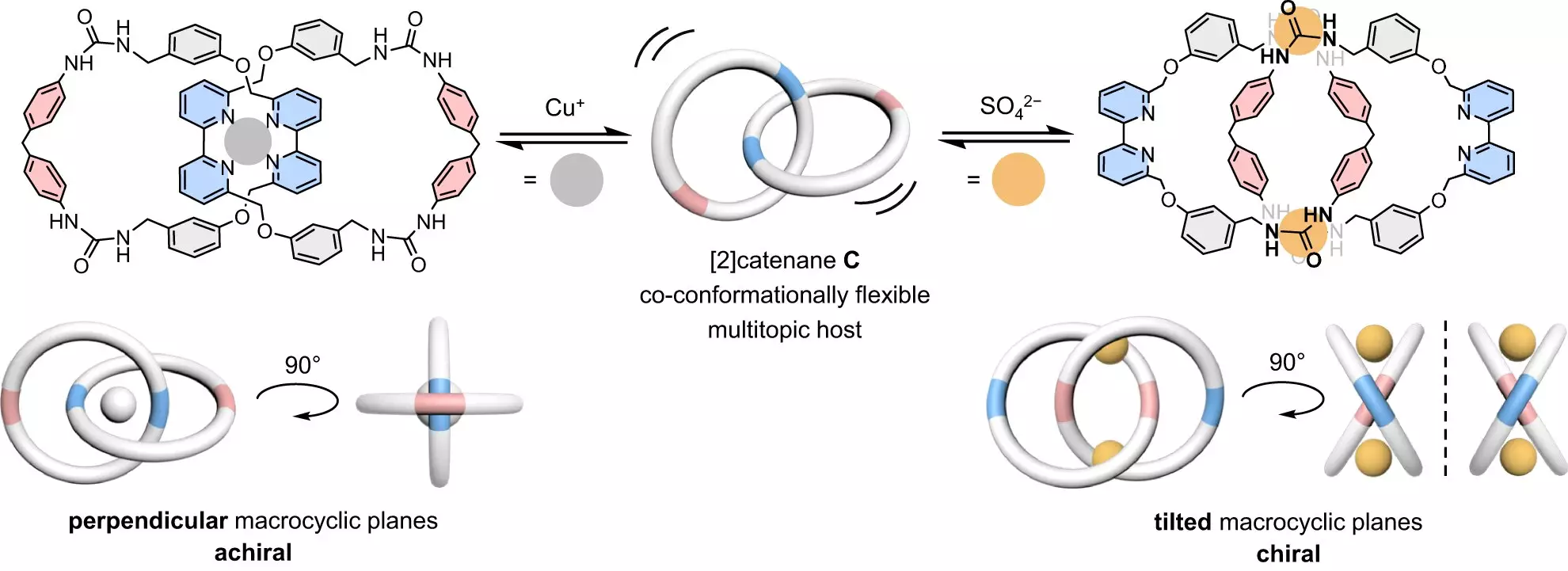In the realm of molecular science, nature often serves as the ultimate teacher, exhibiting remarkable feats of engineering with its simplest components. Everyday items like handcuffs and metal chains provide an insightful analogy for the science of catenanes—complex structures formed by interlinked, rigid components. These structures exhibit an extraordinary synergy, combining flexibility with strength, akin to how two chains might bind while allowing movement. Such natural inspirations underscore the sophistication involved in molecular design and demonstrate the potential of catenanes, particularly in developing molecular machinery.
Catenanes, comprising interlocked macrocyclic compounds, represent a frontier in modern chemistry, known for their unique structural features that could revolutionize fields like molecular switches and nanotechnology. While their synthesis has previously posed significant challenges, ongoing exploration seeks to unravel their potential application in diverse domains. The recent breakthroughs led by Professor Ho Yu Au-Yeung and his team at The University of Hong Kong mark a pivotal step toward unveiling what catenanes can truly accomplish.
Distinctive Ion Recognition: The Key to Innovation
A recent study published in Nature Communications offers fascinating insights into the capacity of catenanes to interact selectively with both copper(I) cations and sulfate anions, two oppositely charged entities with differing geometrical properties. At first glance, enabling a single host to appreciate the nuances of both ions seems almost paradoxical, as they typically evoke repulsive interactions. Yet, Au-Yeung’s team has taken an innovative path to surmount this dilemma by ingeniously designing the catenane with both types of binding sites strategically positioned in their interlocked structure.
This ingenious design mirrors the adaptability of a chameleon, wherein the macromolecules can shift their configurations to optimize binding based on environmental demands. The ability to cater to both copper(I) and sulfate simultaneously confers tremendous potential for applications in environmental monitoring and medical diagnostics. By accurately detecting and differentiating these vital ions, we can advance not only our understanding of biochemical pathways but also build diagnostic tools with enhanced sensitivity and specificity.
Environmental and Biological Implications
Copper(I) ions are essential to various biological systems where they catalyze crucial processes such as cellular respiration and immune function. Similarly, sulfate ions play a role in metabolic pathways that support cellular integrity and function. The newfound ability of the catenane to bind effectively to these ions extends beyond academic intrigue; it opens avenues for practical applications in environmental science. The potential for extracting and recycling essential nutrients from environmental samples poses significant benefits for sustainability efforts and for maintaining ecological health.
As we reflect on the commonplace applications of electrolytes in blood tests, the prospect of developing advanced catenane hosts reveals an intriguing pathway to revolutionizing how we manage health diagnostics. By streamlining the detection of critical ions and minerals, researchers can pave the way for more accurate health monitoring, possibly even predicting health crises before they emerge.
The Road Ahead: Expanding the Horizons of Molecular Design
Looking forward, Professor Au-Yeung and his team aspire to pioneer the development of progressively sophisticated catenane structures capable of binding multiple ions and ion pairs simultaneously. Such advancements promise to not only deepen our understanding of molecular interactions but also invite a wave of innovation across diverse fields ranging from biochemistry to materials science.
The future of catenanes epitomizes a larger narrative emerging in scientific research—one that champions a multidisciplinary approach to problem-solving. By melding the principles of chemistry, biology, and nanotechnology, the potential applications for these intricate molecular machines could rewrite our capabilities in both industrial processes and daily healthcare practices. As the intricacies of molecular interactions continue to unveil themselves, it remains an exhilarating time to explore the expansive landscape of catenane technology and the possibilities that lie therein.


Leave a Reply